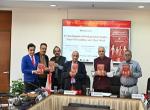In the ongoing VIF series on India and Its Neighbours, an interaction programme was organised on “India-Nepal Economic Dialogue: Unleashing Potentials” on 9 September 2021 in association with the Asian Institute of Diplomacy and International Studies (AIDIA), Kathmandu. The session was chaired by Dr. Sreeradha Datta and Welcome Address was delivered by Dr Arvind Gupta, Director, Vivekananda International Foundation. The eminent speakers in the session included Mr. Sunil KC, Director, AIDIA; Amb Ranjit Rae, Former Ambassador of India to Nepal; H.E. Eshor Raj Poudel, Consulate General of Nepal in Kolkata, India; Mr Sanjay Chadha, Additional Secretary, MEA, India; Ms. Sreejana Rana, President of Nepal India Chamber of Commerce and Industry (NICCI), Nepal; Mr Rakesh Gaur, President, Kalpataru Power Transmission Ltd, India; Mr Ashis Gajurel, Executive Director, Nepal Intermodal Transport Development Board; and Mr Sanjay Jadhav, Vice President & Head of International Operations (South Asia) at Mahindra & Mahindra Ltd, India.
India-Nepal share age-old ties rooted in shared history, culture, society and people. In 2020, India and Nepal completed Seventy Years of their diplomatic relations which have grown tremendously in these seven decades. Meanwhile, since 2015, the bilateral ties have been marred by political differences, often termed as ‘downfall’ in relations. At the same time, the growing economic engagement between the two close neighbours indicates an upward trajectory. For instance, in FY 2020-21Nepal exported USD 670.33 million worth of goods to India accounting 74 per cent of Nepal’s total exports and the rest 26 per cent to the United States, Germany, the United Kingdom, Turkey, France and Germany. At the same time, Nepal imported goods worth USD 6765.35 million from India.
Considering the large volume of Imports from India, the trade deficit has mounted exponentially. The two countries have engaged extensively in discussing Nepal’s trade deficit but on tangible grounds, petroleum products, automobile, machinery products and parts, and telephone sets including cellular phones contribute a major part of India’s export to Nepal. However, Nepal has the potential to export dairy products, manufacture automobile parts and establish assembly units which can sharply reduce the trade gap. India’s leading commercial, agricultural and two-wheeler vehicle manufacturers like Mahindra group remains hopeful of such maiden beginnings in Nepal. Hydropower too, can help minimise trade deficit and balance of payments. At present, India’s SJVN Limited is in the process of completing the Arun III project (900 MW) on the build-own-transfer model, and an agreement was signed in July 2021 by SJVN Limited with Nepal Investment Board to develop Lower Arun Hydro Electricity Project (679 MW). India’s GMR is in the pre-construction phase of developing a 900 MW Upper Karnali Hydro Electricity Project. Nepal can well learn from India-Bhutan Hydro Electricity cooperation where Bhutan earns more than 60 per cent of its GDP by selling power to India. Meanwhile, it will require a political will in the government. Nepal can also focus on manufacturing indigenous products for Indian markets including and consider exporting exotic indigenous fruits like Mustang Apple.
As a landlocked country, Nepal has a well-established transit route through India under the Treaty of Transit. The Haldia Port in West Bengal and Vishakhapatnam Port in Andhra Pradesh facilitate Nepal bound containers which enter Nepal through 15 dedicated trade transit routes through India. Commensurate amendments in the Railway Services Agreement were made in 2021 to facilitate the movement of transit traffic from Vishakhapatnam Port to Nepal via Birgunj Inland Container Depot (ICD Birgunj). There is also an existing Electronic Cargo Tracking System (ECTS) mechanisms for transit cargo on pilot basis and discussions are going on to make it permanent. During the COVID-19 crisis, the India-Nepal border was closed but Port Authority in Kolkata and authorities at transit points ensured a smooth movement of the containers to Nepal, resulting in a great relief to Nepal. The Counsel General of Nepal to Kolkata appreciated India’s efforts during tough times.
With agriculture as the mainstay of Nepal’s economy, lack of fertiliser has troubled farmers in Nepal. Such scarcities of the fertiliser have been exploited by the black marketers who use the open border to smuggle agricultural products and sell at higher prices in Nepal, often unaffordable to low-income farmers. In 2020, the Asian Institute of Diplomacy and International Affairs while hosting India’s Foreign Secretary for an event in Kathmandu had requested for supply of fertiliser to Nepal. The request was immediately accepted and within a short period, India is in the process to supply 1.5 Lakh 50 thousand metric tons fertiliser to Nepal. Similarly, organisations like the Nepal-India Chamber of Commerce and Industry (NICCI) have also worked towards strengthening this economic bond between the business communities of the two countries. This reflects the economic bonhomie between India and Nepal developed over a period of seven decades.
Tourism is another important area which not only exhibits the economic side of the ‘special relations’ but it is a testimony of deeper socio-cultural, philosophical, religious and people to people ties. Indian tourists constitute one the largest of total tourists coming to Nepal. The tourism industry constitutes more than 7 per cent of its GDP. Nepal is home to hundreds of Hindu and Buddhist religious sites that are visited by religious tourists from India every year. During Prime Minister Narendra Modi’s first visit to Nepal in 2014, he visited Pashupatinath Temple and gave a message of religious harmony. He also initiated the idea of the Buddhist Circuit which is evolving. In 2019, a Buddhist Circuit Train had made headlines as it took Indian tourists to Buddhist cities in Nepal.
Other than these mainstream economic areas, cooperation can be extended in urban development, especially in solid waste management in Nepal since India has resources and expertise. Nepal can also work on producing pharmaceutical products in cooperation with India. Automobile and traditional medicines can also open new gateways.
India is currently the second-largest investor in Nepal. Before 2014, India was the top investor in Nepal. However, the technical challenges and bureaucratic hurdles faced by the Indian Investors have led to their withdrawal from Nepal. Historically, Indian companies like Dabur built a mutually beneficial model in Nepal. Meanwhile, such companies are faced with the challenge of lack of concern for Intellectual Property Rights (IPS) in Nepal. The political challenges have also led to the withdrawal of India’s Manipal Group from Pokhara where they were running Manipal College of Medical Sciences. Therefore, there are areas of potential economic cooperation that can help Nepal reduce its dependence and trade deficit with India. Once technicalities and a fast-track mechanism are in place in Nepal, Indian investments will pour in.







Post new comment